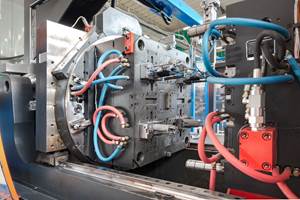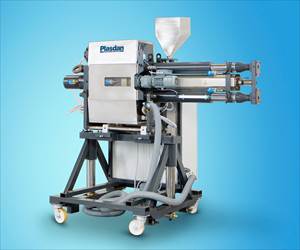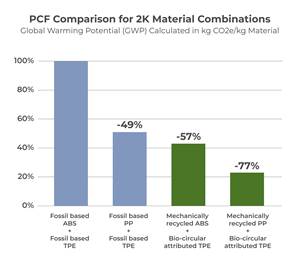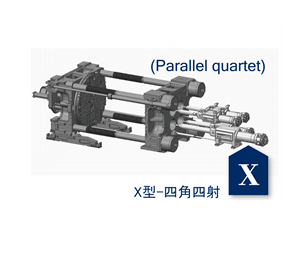Sequential Hard/Soft Injection Molding with Water Assist
In 2004, the value of pairing two-material injection with water assist was demonstrated in production of two-layer automotive pipes and ducts (see Learn More). Further potential for this combination of advanced techniques in sequential injection of hollow automotive parts with rigid and flexible sections is being developed at the German Institute of Plastics Processing (known as the IKV). Water injection technology (WIT) was first developed at the IKV in the 1990s.
TWO SEQUENTIAL APPROACHES
At the Institute’s recent 24th International Colloquium in Aachen, engineering graduate student Andreas Neuss presented the results of his research on sequential hard/soft injection with water assist. Potential applications are air intakes, cooling ducts, and oil lines, as well as non-automotive uses such as clothes-washer lines. Such products have been produced with 3D sequential coextrusion blow molding, but Neuss said such equipment is, in many cases, more expensive than a multicomponent injection machine with water assist.
Neuss examined two alternative methods. The “fluid-bubble transfer” process involves simultaneous injection of the soft component in the center of the duct and of the hard component at either end of the part. Water is then injected from one end. The melt flow front of the hard component at the start of the pipe is forced further by the water and penetrates into the soft segment a short distance. Subsequently, the water passes from the hard segment through the soft segment and then through the hard segment on the other side.
The second approach, called the “melt breakthrough” process, injects the hard component into the center of the duct and the soft component at just one end. The melt front of the soft component encounters the hard component in center of the duct, penetrates it, and breaks through at the opposite side. Then water is injected at one end. In this version, the water flow front remains inside the soft-segment material, which “breaks through” the hard segment and continues beyond it. This results in a hollow two-layer structure at the rigid portion of the duct.
PROCESSING & MATERIALS
Neuss used a 220-ton Ferromatik Milacron K-Tec injection machine with a horizontal barrel to inject the hard component and a smaller vertical barrel to inject the soft component. The materials used were polypropylene for the hard segment and a TPO, TPV, or styrenic TPE as the soft segment. In ongoing research, Neuss will investigate more commercially viable combinations such as glass-reinforced nylon 12 and a flexible nylon 12, PPS with a flexible nylon, or PBT and a copolyester TPE. Materials would have to be chosen for good adhesion to each other and suitability for WIT.
For the fluid-bubble transfer process, Neuss left an air gap between the hard-segment and soft-segment melts, so as to leave room for material that is displaced when water is injected. He also noted that this method produces a transition zone where some of the hard-segment melt penetrates into the soft-segment material, creating a two-layer zone. This transition zone is shortest when the viscosity of the hard-segment melt (where the water bubble is contained) is lower than that of the soft-segment melt into which the water bubble is transferred. Water seeks the easiest path, Neuss explained, so it tends to remain within the most fluid melt. This results in the most reproducible transition zones with least turbulence and mixing.
With the melt-breakthrough process, it is desirable to have the viscosity of the soft-segment melt lower than that of the hard-segment melt that must be penetrated by the other melt stream. This results in short and reproducible rigid segments.
Related Content
Molder Opts for Machine Flexibility for Complex Jobs
AE Plast opted for tiebarless multimaterial Engel victory machines as it took on complex parts for the appliance and power tool market, including a 3K housing for Dremel’s rotary tool.
Read MoreZAG Equipment Sales Partners with Portugal’s Plasdan of Portugal
Under the agreement, ZAG will sell and service Plasdan’s add-on injection units and fully electric rotary tables for multicomponent injection molding.
Read MoreMore Sustainable Two-Component Overmolding
Swedish compounders HEXPOL TPE AB and Polykemi AB have collaborated on a 2K sustainable development project for consumer products.
Read MoreNew Multicomponent Injection Molding Machine Line Launches
FCS Group’s X-Type parallel quartet injection molding machine features four injection units aligned in parallel for a smaller footprint.
Read MoreRead Next
Two-Material Automotive Part Is Cored Out with Water
A three-stage injection process involving nylon, polypropylene, and water assist was demonstrated at the recent K 2004 show in Dusseldorf, Germany.
Read MorePeople 4.0 – How to Get Buy-In from Your Staff for Industry 4.0 Systems
Implementing a production monitoring system as the foundation of a ‘smart factory’ is about integrating people with new technology as much as it is about integrating machines and computers. Here are tips from a company that has gone through the process.
Read More










 (2).jpg;maxWidth=300;quality=90)













